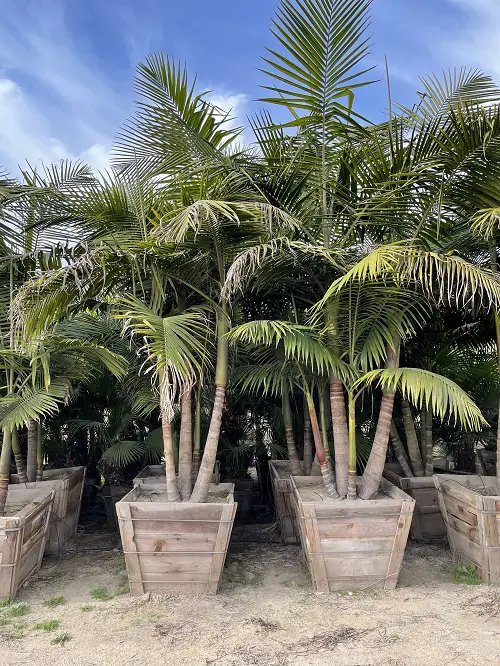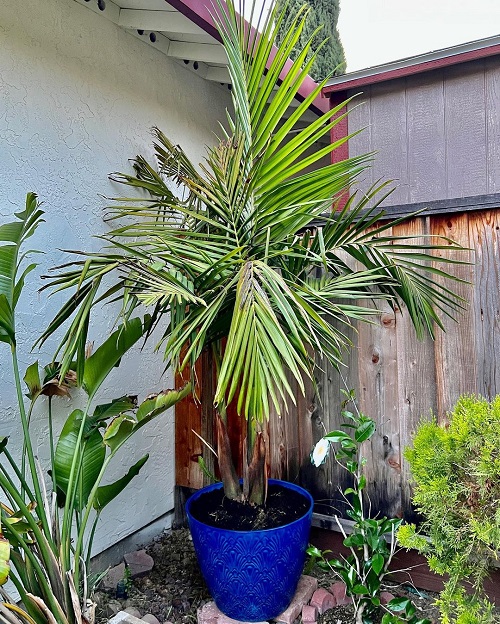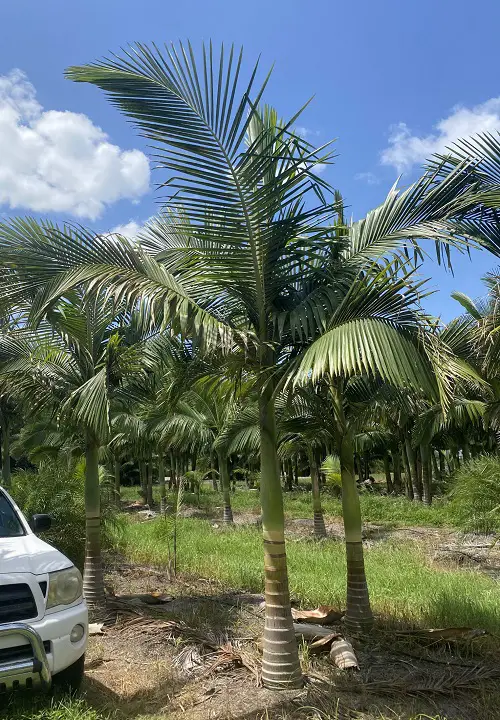Do you want to know about King Palm Tree Care and its varieties? This comprehensive guide has all the details!
The King Palm Tree not only makes for a great focal point in the garden, but it also has several benefits on offer! Let’s have a look at them in detail!
King Palm Tree Information
The King Palm Tree, scientifically known as Archontophoenix cunninghamiana, originates from the rainforests of eastern Australia. It is native to regions along the eastern coast of Queensland and New South Wales.
In its native regions, the King Palm Tree holds cultural significance among the Aboriginal people. The tree’s leaves and trunk were utilized for various purposes, such as making shelters, baskets, and tools.
King Palm Tree features a slender, smooth, and grayish trunk with prominent ring scars from shed fronds. This gives the trunk a distinctive appearance, making it easily recognizable.
The pinnate leaves of King Palm are glossy green and can reach lengths of up to 10 feet. Each leaf has numerous leaflets attached along its length, creating a feathery and elegant appearance.
After flowering, the King Palm Tree produces oval-shaped, bright red fruits that contain a single seed. These fruits attract various birds and wildlife, contributing to the tree’s role in supporting local ecosystems.
King Palm Trees can grow to impressive heights, often reaching 40 to 60 feet tall. This height, combined with its graceful appearance, makes it a popular choice for landscaping in tropical and subtropical regions. The tree’s fronds can spread out to form a canopy with a diameter of approximately 15 to 20 feet, providing ample shade and adding to its visual impact.
Propagating King Palm Tree
Ways to Propagate King Palm Tree
- Seed Propagation
- Offsets or Suckers
- Division
The easiest method for propagating a King Palm tree is through offsets or suckers. Here’s a step-by-step guide.
Offset Propagation:
- Identify Offsets: Look for small shoots or offshoots growing at the base of a mature King Palm. These are often found around the main trunk’s base.
- Prepare the Offshoot: Carefully dig around the base of the offshoot to expose its roots. You might need to use a small shovel or gardening fork.
- Separate the Offshoot: Gently separate the offshoot from the main plant using a clean and sharp knife. Ensure the offshoot has its own set of roots attached.
- Potting: Plant the offshoot in a pot with well-draining soil. The pot should be big enough to accommodate the roots without crowding. Plant the offshoot at a depth similar to its original planting depth.
Best Container Size for Growing King Palm Tree
1. Seedling Stage
- Container Size: 6 to 8 inches in diameter.
- Depth: Ensure that the container has enough depth to accommodate the initial root system.
2. Juvenile Stage
- Container Size: 10 to 12 inches in diameter.
- Considerations: As the palm grows, it will need a larger container to support its expanding root system and foliage.
3. Mature Stage
- Container Size: 18 to 24 inches in diameter or larger.
- Depth: Look for a container that is at least as deep as it is wide to provide ample space for root growth.
Here are Plant Pot Sizes from Inches to Gallon
Requirements for Growing King Palm Tree
Sunlight
The King Palm Tree loves bright, indirect sunlight. It requires 4-6 hours of direct sunlight daily but should not be exposed to harsh, intense sunlight for prolonged periods.
While King Palm Tree prefers sunlight, it’s beneficial to offer them some shade during the hottest parts of the day, especially when they are young or newly planted. Providing shade helps prevent stress and excessive drying out. As King Palm matures, it becomes more tolerant of full sun exposure and can handle longer periods of direct sunlight without damage.
Soil
Type: King Palm Tree thrives in well-draining soil. It’s crucial to choose a soil type that allows water to flow through it easily, preventing waterlogged conditions that can harm the roots. Loamy or sandy loam soils are particularly suitable for these palm trees.
pH Level: Maintaining the soil’s pH within a slightly acidic to neutral range is ideal for King Palm trees. Aim for a pH level between 6.0 and 7.5. This pH range supports the tree’s nutrient uptake and overall health.
Fertility: To enhance soil fertility, it’s recommended to incorporate well-decomposed compost or organic matter into the soil before planting your King Palm tree. This enriched soil provides the necessary nutrients for the young plant’s establishment and growth.
Watering
Frequency: Adequate watering is essential for King Palm trees, particularly when they are young and establishing their root systems. Young King Palm tree should be watered regularly to ensure they receive enough moisture to grow. Once the trees are established, they become more tolerant of drought conditions but still benefit from consistent moisture to maintain their health and appearance.
Method: Deep watering is recommended for the King Palm tree. This means providing a thorough and deep soak to the soil rather than frequent shallow watering. Deep watering encourages the development of deeper roots, which enhances the tree’s ability to withstand periods of drought. It’s important to water deeply enough to reach the root zone, which is generally around the drip line of the tree.
Temperature
- Daytime: 70°F to 85°F (21°C to 29°C)
- Nighttime: 55°F to 65°F (13°C to 18°C)
- Minimum Tolerance: The King Palm Tree can tolerate temperatures down to 28°F (-2°C) for brief periods. Prolonged exposure to such cold temperatures can cause damage.
- Heat Tolerance: While the King Palm Tree is relatively adaptable to warm temperatures, it may suffer in constant heat above 95°F (35°C).
King Palm Tree Care

Fertilizer
- N-P-K Ratio: Look for a balanced slow-release fertilizer with an N-P-K ratio of around 13-13-13 or 15-15-15.
- Micronutrients: Ensure that the fertilizer contains essential micronutrients like magnesium, manganese, and iron, as palm trees are prone to deficiencies in these elements.
– Seedling Stage
- When: Start with a diluted liquid fertilizer once the seedlings have established their first leaves.
- Frequency: Every 6 to 8 weeks.
– Juvenile to Mature Stage
- When: Begin using granular slow-release fertilizer once the palm reaches juvenile status.
- Frequency: Every 3 to 4 months during the growing season (spring to early autumn).
– Application Method
- Granular Fertilizer: Spread evenly around the base of the palm, avoiding contact with the trunk. Water thoroughly after applying.
- Liquid Fertilizer: Follow the manufacturer’s instructions for dilution and apply with watering. Ideally, using it once in 4-6 weeks after diluting it, 1/2 of the recommended strength would be perfect.
Pruning
Avoid pruning King Palm Tree because it can’t heal well after cuts. The scars left by pruning can expose the tree to disease-causing fungi and pests, making it more vulnerable to sickness. Damaged palm trees might get attacked by a harmful fungus called “pink rot,” which can be deadly.
Instead of cutting off old leaves, let them fall naturally as new ones grow. This way, your palm tree can stay healthy without needing to be trimmed.
Pests and Diseases
Regularly inspect your King Palm tree for signs of pests or diseases and take prompt action if detected. Common pests include.
- Aphids: Small insects that feed on plant sap and can cause stunted growth and leaf distortion.
- Scale Insects: Tiny insects that attach themselves to the plant and suck out the sap, weakening the palm.
- Mealybugs: Soft-bodied insects that feed on plant juices and produce a white, waxy substance.
- Spider Mites: Tiny pests that suck the chlorophyll from leaves, causing stippling and yellowing.
- Palm Weevils: These beetles lay eggs in the palm’s crown, and their larvae bore into the trunk, causing structural damage.
Also, be cautious about the water around the roots. If the water doesn’t drain properly, the roots could start rotting. So, it’s smart to plant your palm tree in soil that lets water flow away.
Growing Areca Palm Indoors | How to Grow Areca Palm
Best King Palm Tree Varieties
The King Palm Tree, also known as Archontophoenix cunninghamiana, has a few different forms and related species that are noteworthy for various landscapes. Here’s an overview of some of the best King Palm varieties and related species.
1. Archontophoenix cunninghamiana (Bangalow Palm or King Palm)
- Appearance: Graceful, feather-like fronds and a sleek, smooth trunk.
- Growth Habit: Can grow up to 50-70 feet tall.
- Ideal for: Formal gardens, avenue planting, or as a standalone specimen.
2. Archontophoenix alexandrae (Alexandra Palm)
- Appearance: Similar to the Bangalow Palm but with a slightly more slender trunk.
- Growth Habit: Reaches heights of 40-60 feet.
- Climate Preference: Thrives in slightly more humid environments.
- Ideal for: Creating a tropical ambiance in gardens and landscapes.
3. Archontophoenix purpurea (Purple King Palm)
- Appearance: Notable for its purple-hued crown shaft and more robust trunk.
- Growth Habit: Usually grows up to 50 feet tall.
- Climate Preference: Similar to the other King Palms but tends to be a bit hardier.
- Ideal for: Adding unique color and character to landscapes.
4. Archontophoenix myolensis (Myola King Palm)
- Appearance: Features finer, more delicate fronds.
- Growth Habit: Typically reaches heights of 40-50 feet.
- Climate Preference: Prefers a humid subtropical climate.
- Ideal for: Smaller gardens or as a part of a mixed palm display.
Neanthe Bella Palm Care | How to Grow Parlor Palm Indoors
King Palm Tree vs Queen Palm Tree
1. Appearance
King Palm Tree
- Fronds: Feather-like, glossy green fronds that arch gracefully.
- Trunk: Smooth, slender, and gray-green, often with a more pronounced crown shaft.
Queen Palm Tree
- Fronds: Slightly stiffer, dark green fronds.
- Trunk: Smooth, gray, and straight with no crown shaft.
2. Growth Habits
King Palm Tree
- Height: Can reach up to 50 feet.
- Growth Rate: Moderate.
Queen Palm Tree
- Height: Typically grows to 30-50 feet.
- Growth Rate: Fast.
3. Environmental Tolerance
King Palm Tree
- Temperature: Prefers warmer tropical to subtropical climates.
- Soil: Likes well-drained, slightly acidic to neutral soils.
Queen Palm Tree
- Temperature: Adaptable to a range of climates but prefers warm conditions.
- Soil: Prefers well-drained, sandy loam soil and tolerates a wider pH range.
King Palm Tree For Sale
1. Local Nurseries and Garden Centers
- Support local businesses by checking with nearby nurseries and garden centers.
- Benefit from expert advice tailored to your local climate and soil conditions.
2. Online Retailers
- Many reputable online stores specialize in palm trees and offer a variety of sizes.
- Check customer reviews and ratings to ensure quality and authenticity.
3. Big-Box Retailers
- Some large home improvement and garden stores carry a selection of palm trees, including the King Palm Tree.




